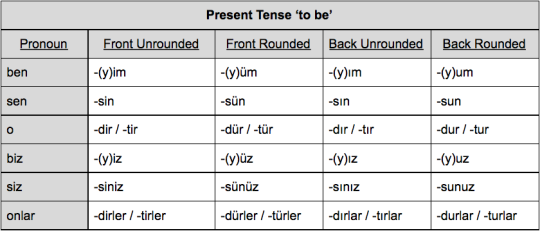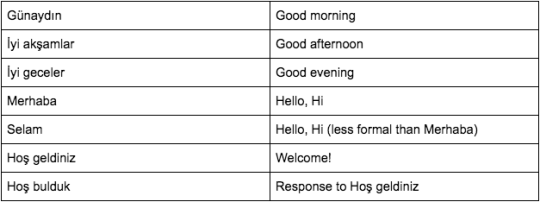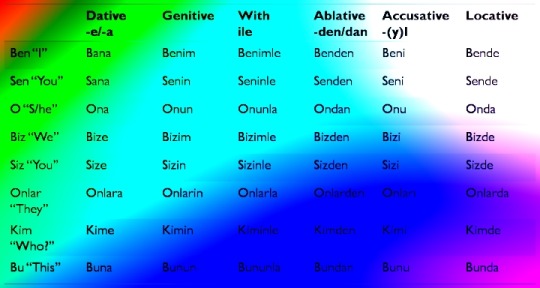Text
How to learn a language when you don’t know where to start:
General Plan:
Weeks 1 and 2:
Purpose:
Learn the fundamentals sentence construction
Learn how to spell and count
Start building a phrase stockpile with basic greetings
The Alphabet
Numbers 1 - 100
Subject Pronouns
Common Greetings
Conjugate the Two Most Important Verbs: to be and to have
Basic Definite and Indefinite Articles
Weeks 3 and 4:
Purpose:
Learn essential vocabulary for the day-to-day
Start conjugating regular verbs
Days of the Week and Months of the Year
How to tell the time
How to talk about the weather
Family Vocabulary
Present Tense Conjugations Verbs
Weeks 5 and 6:
Purpose:
Warm up with the last of the day-to-day vocabulary
Add more complex types of sentences to your grammar
Colours
House vocabulary
How to ask questions
Present Tense Conjugations Verbs
Forming negatives
Weeks 7 and 8:
Purpose:
Learn how to navigate basic situations in a region of your target language country
Finish memorising regular conjugation rules
Food Vocabulary and Ordering at Restaurants
Money and Shopping Phrases
Present Tense Conjugations Verbs
Weeks 9 and 10:
Purpose:
Start constructing descriptive and more complex sentences
Adjectives
Reflective verbs
Places vocabulary
Weeks 11 and 12:
Purpose:
Add more complex descriptions to your sentences with adverbs
Wrap up vocabulary essentials
Adverbs
Parts of the body and medical vocabulary
Tips for Learning a Foreign Language:
Learning Vocabulary:
What vocabulary should I be learning?
There are hundreds of thousands of words in every language, and the large majority of them won’t be immediately relevant to you when you’re starting out.Typically, the most frequent 3000 words make up 90% of the language that a native speaker uses on any given day. Instead try to learn the most useful words in a language, and then expand outwards from there according to your needs and interests.
Choose the words you want/need to learn.
Relate them to what you already know.
Review them until they’ve reached your long-term memory.
Record them so learning is never lost.
Use them in meaningful human conversation and communication.
How should I record the vocabulary?
Learners need to see and/or hear a new word of phrase 6 to 17 times before they really know a piece of vocabulary.
Keep a careful record of new vocabulary.
Record the vocabulary in a way that is helpful to you and will ensure that you will practice the vocabulary, e.g. flashcards.
Vocabulary should be organised so that words are easier to find, e.g. alphabetically or according to topic.
Ideally when noting vocabulary you should write down not only the meaning, but the grammatical class, and example in a sentence, and where needed information about structure.
How should I practice using the vocabulary?
Look, Say, Cover, Write and Check - Use this method for learning and remembering vocabulary. This method is really good for learning spellings.
Make flashcards. Write the vocabulary on the front with the definition and examples on the back.
Draw mind maps or make visual representations of the new vocabulary groups.
Stick labels or post it notes on corresponding objects, e.g when learning kitchen vocabulary you could label items in your house.
How often should I be practising vocabulary?
A valuable technique is ‘the principle of expanding rehearsal’. This means reviewing vocabulary shortly after first learning them then at increasingly longer intervals.
Ideally, words should be reviewed:
5-10 minutes later
24 hours later
One week later
1-2 months later
6 months later
Knowing a vocabulary item well enough to use it productively means knowing:
Its written and spoken forms (spelling and pronunciation).
Its grammatical category and other grammatical information
Related words and word families, e.g. adjective, adverb, verb, noun.
Common collocations (Words that often come before or after it).
Receptive Skills: Listening and Reading
Reading is probably one of the most effective ways of building vocabulary knowledge.
Listening is also important because it occupies a big chunk of the time we spend communicating.
Tips for reading in a foreign language:
Start basic and small. Children’s books are great practice for beginners. Don’t try to dive into a novel or newspaper too early, since it can be discouraging and time consuming if you have to look up every other word.
Read things you’ve already read in your native language. The fact that you at least know the gist of the story will help you to pick up context clues, learn new vocabulary and grammatical constructions.
Read books with their accompanying audio books. Reading a book while listening to the accompanying audio will improve your “ear training”. It will also help you to learn the pronunciation of words.
Tips for listening in a foreign language:
Watch films in your target language.
Read a book while also listening along to the audio book version.
Listen to the radio in your target language.
Watch videos online in your target language.
Activities to do to show that you’ve understood what you’ve been listening to:
Try drawing a picture of what was said.
Ask yourself some questions about it and try to answer them.
Provide a summary of what was said.
Suggest what might come next in the “story.”
Translate what was said into another language.
“Talk back” to the speaker to engage in imaginary conversation.
Productive Skills: Speaking and Writing
Tips for speaking in a foreign language:
If you can, try to speak the language every day either out loud to yourself or chat to another native speaker whether it is a colleague, a friend, a tutor or a language exchange partner.
Write a list of topics and think about what you could say about each one. First you could write out your thoughts and then read them out loud. Look up the words you don’t know. You could also come up with questions at the end to ask someone else.
A really good way to improve your own speaking is to listen to how native speakers talk and imitate their accent, their rhythm of speech and tone of voice. Watch how their lips move and pay attention to the stressed sounds. You could watch interviews on YouTube or online news websites and pause every so often to copy what you have just heard. You could even sing along to songs sung in the target language.
Walk around the house and describe what you say. Say what you like or dislike about the room or the furniture or the decor. Talk about what you want to change.This gets you to practise every day vocabulary.
Tips for writing in a foreign language:
Practice writing in your target language. Keep it simple to start with. Beginner vocabulary and grammar concepts are generally very descriptive and concrete.
Practice writing by hand. Here are some things you can write out by hand:
Diary entries
Shopping lists
Reminders
What could I write about?
Write about your day, an interesting event, how you’re feeling, or what you’re thinking.
Make up a conversation between two people.
Write a letter to a friend, yourself, or a celebrity. You don’t need to send it; just writing it will be helpful.
Translate a text you’ve written in your native language into your foreign language.
Write a review or a book you’ve recently read or a film you’ve recently watched.
Write Facebook statuses, Tweets or Tumblr posts (whether you post them or not will be up to you).
Write a short story or poem.
Writing is one of the hardest things to do well as a non-native speaker of a language, because there’s no room to hide.
There are lots of ways to improve your writing ability, but they can be essentially boiled down to three key components:
Read a lot
Write a lot
Get your writing corrected
28K notes
·
View notes
Note
Hello, do you have any resorces to learn Egyptian arabic? And is duolingo's arabic closer to Egyptian? Im more interested to be able to read and understand the language than speaking it (I know it's weird lol). I already can read but I have no Idea what I'm reading and what they should sound like.
Thank you, and have a good day!
Hi!
Here is a link of Egyptian Arabic resources I’ve put together (some of the resources are rather old, however, they are all complete books, some contain Arabic script. Save the link bc I update the folder every now and again, so any incomplete series of books may be completed in the future).
Egyptian Arabic PDF’s
In my opinion, Duolingo's Arabic is just Modern Standard Arabic, however, it is good for practising reading and the basic pronunciation skills.
Here are some useful websites!
Egyptian Arabic with Mimo
Egyptian Arabic dictionary
Teach Yourself Books:Colloquial Arabic ( Egyptian Arabic ) - This is quite an old book
An Arabist’s guide to Egyptian colloquial
Egyptian Colloquial: 18 Lessons For Beginners (Audio Book )
An Introduction to Egyptian Arabic
A Comprehensive Study of Egyptian Arabic 4 Volumes
Say It in Arabic (Egyptian dialect)
76 notes
·
View notes
Text
How to Overcome a Studying Slump
Also known as procrastination, inertia, laziness, lack of motivation, or revision slump [for those of you who speak British English] (note: there are many causes! & it is always good to address your mental health first of all)

Find some motivation: That may be sourced from a famous figure, someone you know personally, social media personality, the studyblr community, or even just encouraging words. Briefly write out a list of reasons why that person inspires you or a list of quotes that inspire you. (If this step seems hard, compare your situation with people today [and of the past] who are restricted from going to school at all…do it for those who don’t even have your opportunities)
Find purpose in your work. You may not care about the particular subject you are studying but think about what you can gain from knowing that information regardless (better brainpower, random trivia knowledge, better grades, or you may discover an interest in an adjacent field). If the subject is in line with your dreams, keep that in perspective with visualizations.
Face the facts. Studying does work. That time you scored 95% when you didn’t study (whereas you got a 75% after studying another time) was a fluke…a mere coincidence.
Get your mind focused: Social media can wait. Your school drama will pass but your regret of not studying for your midterm will linger. The fear of failing your next test can only be defied if you do something to prevent it. Now, create YOUR perfect studying atmosphere (this requires you knowing yourself very well). Put away your phone (or put it on “Do not disturb” or turn it off or give it to someone else for a bit…whatever works for you). Put on music (I recommend classical or “lo fi beats to study/relax to”) or create silence or go somewhere with lots of chatter. Then, write out a detailed list of all the ideas that you need to review and check them off as you go!
Find a method that works for you. You have to know if you learn better from visual/spatial (make mindmaps/study guides/graphic organizers + use different colors or fonts + get comfortable with the layout of your textbook + mind palace technique), auditory/verbal (listen to material on the subject/record your lectures if possible + vocalize it back + converse with people with a proficiency in the subject + feynman technique + mnemonics), kinesthetic (review while doing another activity eg. bouncing a ball + flashcards + take notes + don’t allow yourself to sit for too long) or interpersonal cues (study groups/tutoring sessions/labs + act out the material for others + teach someone else + recall what happened in class when you learned a certain topic). Generally, writing the information will work if your test will be on paper or vocalizing your ideas if you are preparing a presentation/speech/debate. Study in a group only if you learn better that way (if you get too distracted or find that the review is never at a good pace for you, either write out notes & questions before and address them in the group AND/OR just teach the material to a stuffed animal or someone with limited knowledge on the topic).
Make it fun. Use a color coding system with your highlighters. Use a new app (Memrise instead of Quizlet). Make a cute study guide. Make a song out of your material. Watch videos on Youtube with the content. Find things to laugh at in your textbook. Make mnemonics so ridiculous that you have to remember them (take inspiration from whoever created “Please Excuse My Dear Aunt Sally”…I always wanted to know what poor Aunt Sally did).
Give yourself rewards. Eat a few pieces of a snack (I recommend something which is good for your brain: walnuts, dark chocolate, avocado, pumpkin seeds, blueberries) once you reach a milestone (eg. 4 pgs of reading, 1 page of study guide, every 20 mins). Or watch a few minutes of your favorite show after every interval (caution: don’t forget about your studies!) or if you don’t trust yourself that much…watch a video from studytube. Or promise yourself things after the study session is throughly completed (eg. time out with friends, a mini spa night, takeout…i don’t recommend anything too expensive).
Know your limits. BURNOUT IS POSSIBLE. Trust me. Make sure that you are still getting time for non-academic fun and getting time outside as well. YOUR BODY WAS NOT DESIGNED TO STUDY FOR DAYS ON END. If you do have a longer study session make sure to keep hydrated & energized with water and food (and not too much caffeine).
Now, once all that has been established, make it a daily (or nearly daily) habit. Study as soon as you learn something new. Exercise that muscle of yours [your brain]. Your 5 hours study session will be a thing of the past. Only needing 2 hours now, you will be afforded an extra 3 hours to watch Netflix, cook, draw, go to the gym, go to the beach, take a nap, take a bath, or make a study schedule with + for a friend who recently experienced burnout.
3K notes
·
View notes
Text
10 REASONS YOUR LISTENING SKILLS ARE NOT IMPROVING
a v v v good reddit submission.
I really need to make a system for learning vocab - what about you?
Link ~ https://www.reddit.com/r/French/comments/kmmfx1/10_possible_reasons_why_your_listening_skills_are/
64 notes
·
View notes
Text
Some ACTUALLY GOOD CARTOONS/ANIME that offer FRENCH DUB [according to Netflix UK+ France.TV]
I’m 21 and still love cartoons and anime haha - not that there’s an age limit. I thought it’d be a good idea to at least share some shows I love watching that offer French dub in my country. Furthermore, I’ve categorised them to their ‘target demographics’ purely because I know some people don’t mind cartoons geared towards children [like myself] whereas others prefer shows with more adult themes/for teens +. These are also good shows to watch if you don’t like watching dubbed shows because of the ‘out of sync’’ feeling it has.
Disclaimers: Some shows are actually French/originally made in French lol: Heidi, Wakfu. *Most of the shows I’ve seen all the way through, and even rewatching!. Shows I have yet to finish are Wakfu and Voltron.* These are shows available in the UK. Some are Netflix original series, so they’ll be available worldwide however, with shows like Rick and Morty, Heidi, and One Punch Man, availability will depend on your territory.
I will add more details of shows if people want them haha.
NETFLIX
POUR ENFANTS

HILDA - Il s’agit d’une jeune fille qui s’appelle Hilda. Elle aime explorer le monde magnifique autour d’elle. Avec ses amis, elle apprend des leçons fondamentales. Je dirais que cette émission qui est basée sur un BD britannique est assez cool et originale. Je vous recommande cette émission si vous aimiez Heidi.

Heidi - Bref, Heidi est une jeune orpheline qui continue a être optimiste malgré sa situation. On regarde sa vie dans les montagnes et plus tard dans la grande ville!

SPIRIT: au galop en toute liberté - Lucky, le personnage principal, déplace de la ville aux campagnes ou elle apprend l'équitation. Elle doit s’adapter a sa nouvelle vie.

Wakfu - “La vie du jeune Yugo change a jamais lorsqu;il découvre qu'il est capable de créer des portails de téléportation.” Cette émission est fondée sur un jeu vidéo. On peut voir qu’il y a une influence d’anime.
LES JEUNES

Les Têtes Vides/ The Hollow

Le Prince Des Dragons

Voltron

Blue Exorcist

One Punch Man
LES ADULTES

Rick and Morty -C'est Rick et Morty. Rick est l'homme le plus intelligent de l'univers. Morty est le petit-fils naïf, jeune et curieux de Rick. Suivez-les dans leur exploration de l'univers.

Big Mouth - Un moyen d’apprendre ou revivre la puberté mdr.

Gambling School - Il s’agit d’un lycée japonais ou les éleves sont des victimes d’une hiérarchie. Votre classification au lycée est tellement importante pour survivre. Comment etre au top de la hiéarchie? - On doit jouer!!
FRANCE.TV [Must use with VPN unless you live in French territory. It is free, and offer CC subtitles. :)]
Je ne vais pas expliquer ATLA et La Légende de Korra parce qu’ils sont tellement connus. Reregardez-les en français!

La légende de Korra

ATLA
68 notes
·
View notes
Text
Turkish Lesson 4: The Plural Suffix
Plurals are an essential part of daily speech in any given language. They’re the backbone of simple conversations and they could save you from many sticky situations.
In Turkish, the meaning of plurality is added to a word with the suffixes “-lar” or “-ler”.
noun + “-lar” / “-ler”
Figuring out which of these is the proper suffix to use is very simple if you get the hang of vowel harmony from the previous lesson. That’s a key skill for any subject in Turkish.
If the noun’s last syllable has a back vowel (kalın ünlü) it will get the suffix -lar
If the noun’s last syllable has a front vowel (ince ünlü) it will get the suffix -ler
Examples:
Ağaçlar (trees)
Çiçekler (flowers)
Limanlar (harbours)
As you can see this rule only applies to the last syllable of each word. Even though the word “liman” doesn’t fit palatal vowel harmony, we still add the suffix in accordance to the last vowel in the word.
Note: There are very few foreign words that don’t follow this rule. Although the amount of exceptions are very minimum, some notable ones are:
Metaller (metals)
Roller (roles)
Ampuller (lightbulbs)
Saatler (hours)
Another very important rule of Turkish plurals is in the counting. Unlike most Indo-European languages, when counting how many of something there is we don’t make the noun plural.
Examples:
iki kediler ✖ iki kedi ✔ (two cats)
beş adımlar ✖ beş adım ✔ (five steps)
üç kuşlar ✖ üç kuş ✔ (three birds)
90 notes
·
View notes
Text
Podcasts too! Spotify has an amazing selection
~ resources for autodidacts/polymath aspirations ~
B-ok.cc
Wikibooks
Wikipedia
Reddit
Mango Languages
Duolingo
Youtube
Archive.org
Quizlet
Google Scholar
Research Journals
Where is Scihub Now
For Dummies type series
University Published Primers/Introductions
Textbooks

17 notes
·
View notes
Text
Turkish Lesson 3: Vowel Harmony & ‘to be’
Welcome back to another Turkish lesson! Today we’re going to talk about a very important feature of the Turkish language: vowel harmony! So in Turkish, vowels are classified by a couple of features and then vowels with the same features go together. In native Turkish words, usually all the vowels will share the same features; however, the more important part of this is that, when we’re adding the suffixes that Turkish is famous for (cf. agglutination), the vowels in the suffixes need to match the features of the last vowel in the word. Don’t worry, we’ll practice with it and you’ll get used to it over time. Let’s look at the types of vowels first.
Major Vowel Harmony: Front vs. Back
The first main distinction is that of where the vowel is pronounced in the mouth. There are two types in Turkish: front (ince ünlü) and back (kalın ünlü).
(Note: Every vowel has its opposite pair- thus, the way they’re ordered in writing.)
Front Vowels: e, i, ö, ü
Back Vowels: a, ı, o, u
The Front Vowels, you’ll notice, are pronounced in the font of the mouth, and have dots (except e). The Back Vowels, however, are pronounced in the back of the mouth, and do not have dots. So, the important of this rule is that when we have a suffix, like the plural suffix -lar, it needs to match the final vowel of the word its being attached to. This also means that there are two (though sometimes more for other suffixes) forms of this suffix: -lar and -ler. Let’s look at some examples.
Ağaç > ağaçlar (trees)
Liman > limanlar (harbors)
Çocuk > çocuklar (children)
Çiçek > çiçekler (flowers)
Kedi > kediler (cats)
Note: There are a few foreign words that don’t follow this rule. Although the exceptions are few, some notable ones are:
Metaller (metals)
Roller (roles)
Ampuller (lightbulbs)
Saatler (hours)
Minor Vowel Harmony: Rounded vs. Unrounded
The second type of vowel harmony has to do with how the vowel is pronounced, in particular if it is rounded or not. By rounded vowels, we mean if the lips are rounded during pronunciation.
Rounded Vowels: ü, u, ö, o
Unrounded Vowels: i, ı, e, a
So, just as front vowels have to be followed by other front vowels, and back vowels have to followed by other back vowels, rounded vowels need to be followed by other rounded vowels, and unrounded vowels need to be followed by other unrounded vowels. This is verb important because the vowels in Turkish suffixes usually have 2 variants: (1) V2 (picking between e/a for front and back) and V4 (picking between front and back and rounded and rounded, with the options i/ı/ü/u). The verb ‘to be’ has this 4-vowel variant.

So that might look like a lot, but it actually isn’t - vowel harmony is really just adjusting vowels to match the word you’re already saying and thus ease your speech and pronunciation. But, for practice, let’s look at 4 adjectives that fall into each one of these vowel categories.

Note: We will discuss later when to add the /-y-/ in the ben and biz forms, as well as when to select the /d/ and the /t/ in the o and onlar forms. Also, the third person (o/onlar) often drops the actual verb ‘to be’ when it’s understood from context. Thus, you will often see forms like “O hasta.” (She is sick) or “Çocuklar mutlu.” (The children are happy.) This form, however, is always use when emphasizing something or when declaring facts (ie. Kedi(ler) hayvandır. ‘Cats are animals.’)
The Negative
The negative form of the verb ‘to be’ in Turkish is the word değil. For the o and onlar forms, it doesn’t take a suffix (as mentioned above, though you might see for emphasis değildir); however, for all the other forms, it does.

Practice: Take the following nouns and adjectives and write positive and negative statements describing yourself and others.
Buyuk - big
Küçuk - small
Öğrenci - student
Öğretmen - teacher
Eski - old (thing)
Yeni - new
Yaşlı - old (person)
Genç - young
Ev - house
Şehir - city
52 notes
·
View notes
Text
Turkish Lesson 2: Greetings & Introductions
Hoş geldiniz and Welcome to Lesson 2 of Turkish! Today, we’re going to look at how to greet people and introduce yourself. If you’re just joining us and don’t know the Turkish alphabet, or the pronunciation of Turkish, check out our first lesson here. Now, let’s start with a dialogue.

So let’s start taking this apart with some basic greetings. In Turkish, here are some of the more common greetings you’ll come across:

Now the next important part of this dialogue is asking how someone is doing, but before we get to that let’s learn the subject pronouns in Turkish, because they’re important when speaking about ourselves and to others.

Ok, so we see that Ali asks Ahmet “Nasılsın?” which means, “How are you?” The word “nasıl” means “how, what sort of?”. That means that the suffix “-sın” is our verb “to be”. We’re going to discuss vowel harmony in the next lesson; so for now, let’s just look at how you might commonly use “nasıl” when asking about someone or something’s condition.

Then we see Ahmet’s response of “İyiyim” meaning “I’m fine” or “I’m well.” Once again, the verb “to be” in Turkish can have many forms due to vowel harmony (see next lesson); so, let’s look at how you could respond to our previous questions using the adjective “iyi” meaning “good”.

You’ll notice the shift from the use of the vowel ı to i when we shifted from nasıl to iyi. This is because of vowel harmony, which is a very important part of the Turkish language. We’ll be discussing it in our next lesson; but for now, let’s continue on!
Once Ahmet and Ali have finish greeting each other, we see Tülin walk up and join the conversation. She introduces herself saying “Benim adım Tülin.” meaning “My name is Tülin.” Benim means “my” and adım means “my name”. Yes, she repeats “my” twice, but this is not incorrect in Turkish; it’s perfectly acceptable. Let’s look at how to introduce ourselves, as well as others.

Since the suffixes on the end of the noun ad (name) also show possession, it is perfectly alright to remove the first word from these phrases when the possessor is understood in context (i.e. ‘benim adım’ and just ‘adım’ mean the same thing).
The dialogue continues with each character introducing themselves using the phrases “Memnun oldum” and “Tanıştığımıza memnun oldum” meaning “It’s nice to meet you”.
We see Ali introduce himself saying “Benim aldımda Ali.” meaning “My name is also Ali.” This “-da” (also) here doesn’t mean that someone else’s name is Ali, but rather Ali is taking the time to introduce himself in return much like saying “Well me, my name is Ali.” We saw the word “-da” earlier when Ali told Ahmet “Bende iyiyim.” meaning “I’m also well.” Here it does mean also/too, but it’s spelled “-de” due to vowel harmony (which we will see in the next lesson).
Let’s finish this lesson with a review of important words in addition to our list of greetings and personal pronouns from above.

Now, if you’d like some sort of homework, try writing short dialogues greeting people, asking about their (or someone else’s) condition, and having them introduce themselves. And get ready for next week when we’ll learn the present tense of ‘to be’ and the rules of vowel harmony!
44 notes
·
View notes
Text
Intro to Turkish
The Turkish language (türkçe) is a Turkic language spoken in the Republic of Turkey. There are approximately 71 million native speakers of Turkish, and another 17 million second-language speakers. It is the official language of the Republic of Turkey, Northern Cyprus, and Cyprus, as well as a recognized minority language throughout the Balkans.
The Turkish language is part of the Western Oghuz Branch of the Turkic Language family. Other members of this branch are Azerbaijani and Gagauz. Other Oghuz Turkic languages include Turkmen, Khorasani Turkic, and Qashqai. If you haven’t heard of these, other Turkic languages (the more distant relatives of Turkish) that you might have heard of include Uzbek, Kazakh, Kyrgyz, Uyghur, Tatar and more.
Turkish Literature
The Turkish language has a long history of literature, especially poetry, starting in about the 8th century AD. One of the earliest sources of Turkish Literature comes from the early (Islamic) Iranian Empires (Seljuks, Qajars, etc.), most of whom were considered ‘ethnically’ Turkic, but ‘culturally’ Persian. Later, much of this literature and poetry was written in Ottoman Turkish, the official language of the Ottoman Empire. Ottoman Turkish was written in the Perso-Arabic script, but is not all that different from Modern Turkish as a language. It was in the late-19th century and early-20th century, especially during the time of Mustafa Kemal Atatürk, that the Turkish language went through a series of reforms, including a change of the writing system from the Perso-Arabic script to the Latin alphabet.
Modern Turkish literature was affected by Western literature, especially French. Because of this, authors and poets started to write more about love and such feelings other than religious stories and poems. With the Edict of Gülhane, their work got even more original and better. Ahmet Mithat Efendi, Şemseddin Sami, Namık Kemal are just a few of the best authors of their time. After a few more years the literature was all modern- Mehmet Akif Ersoy, Ömer Seyfettin, Nazım Hikmet, Peyami Safa, Orhan Veli Kanık, Orhan Pamuk… were the ones who tried to make literature contemporary and they are still very important to Turkish people.
Features of Turkish
Like other Turkic languages, the Turkish language is agglutinative, meaning that suffixes and infixes (and some prefixes) are systematically added to words to create meaning. Because of this, words in Turkish can become quite long. A famous example of this is the Turkish word muvaffakiyetsizleştiricileştiriveremeyebileceklerimizdenmişsinizcesine, which means something like “(you are talking) as if you are one of those that we cannot easily convert into an unsuccessful-person-maker” (someone who un-educates people to make them unsuccessful). [Source] Now, this is an extreme case; but part of the beauty (and ease) of Turkish is its regular use of suffixes to build more complex meaning. This might seem difficult at first, but will be your best friend in learning.
Like other languages of West Asia, Turkish has received a number of loanwords from its neighbors, especially Persian and Arabic. So, if you speak one of these languages, you might recognize a lot of Turkish vocabulary already. Often, you will see an Arabic loanword with multiple Turkish endings attached to it. This is completely normal for Turkish.
The bright side for students of Turkish is that it’s written with a modified of the Latin alphabet. There are some new letters and sounds you will have to get used to, but they will come quickly. Sometimes, the spelling of Turkish suffixes change; this is called vowel and consonant harmony. This might seem confusing at first, but it’s entirely based on pronunciation. The idea is that words with certain vowels should contain suffixes with the same or similar vowels, or that consonants in contact should change to match each other. This is just writing reflecting natural changes in pronunciation, and you will grow used to this logic.
Overall, the Turkish language is a beautiful, and very unique language in the world of West Asian languages. We hope that you enjoy learning Turkish with us! Remember to send us any questions you have or requests of what you’d like to see in our lessons and posts!
136 notes
·
View notes
Text
Turkish Lesson 1: Alphabet / Alfabe
The building blocks of any language is phonetics, so we’re going to start our Turkish lessons with basic pronunciation of vowels and consonants! (You can listen to these sounds here.)
The Turkish language has 8 vowels, and they are:
A - as in father
E - as in jet
I - as in cousin
İ - as in meet
O - as in phone
Ö - as in burn (without the r)
U - as in push
Ü - as in uber
The language has 21 consonants which are:
B - as in Bee
C - as (the j) in Jacket
Ç - as in the ‘ch’ sound; Chair
D - as in Dad
F - as in For (Also same as the ‘ph’ sound)
G - as in Great
H - as in Hair
J - as (the j) in Azure (also the zh sound)
K - as in Kill
L - as in Love
M - as in My
N - as in Need
P - as in Place
R - as in Reference (but with your tongue like the Spanish r)
S - as in Side
Ş - as in the ‘sh’ sound; She
T - as in Turkey
V - as in Western (sorta in between an English v and w)
Y - as in You
Z - as in Zero
And then we have the “Ğ/ğ” which is the 9th letter of the alphabet. There’s no word starting with ‘ğ’ we always use it in the word. So with this letter we have 2 cases
Vowel+ğ+vowel; We don’t pronounce it. So it’s silent. Like you pronounce Ağa as Aa
Vowel+ğ+consonant; It is still silent but lengthens the previous vowel. So you pronounce the word ‘Tuğra’ as ‘Tooora’
Here are some words that Turkish people use in their daily lives. Practice pronouncing them.
Merhaba/Selam: Hello/Hi
Nasılsın?: How are you?
Günaydın: Good morning
İyi akşamlar: Good evening
İyi geceler: Good night
İyi günler: Have a good day
Afedersin: Excuse me
Özür dilerim: I’m sorry
Teşekkür ederim: Thank you
Hoşçakal: Goodbye
Sonra görüşürüz: See you later
Tune in next week to see how we introduce ourselves in Turkish! Hoşçakal!
173 notes
·
View notes
Text
Turkish Articles
Article ‘the’
There is no Turkish word for the subject definite article, only the context tells us when to insert the in English:
Siyah arabası var. He has a black car.
Araba caddede. The car is in the road.
The indefinite article ‘bir’
English equivelent form is ‘a’ or ‘an’ and you can omit ‘bir’ if you want.
He is a father. O bir babadır.
I’m a student. Ben bir öğrenciyim. / Ben öğrenciyim. / Öğrenciyim.
(These three sentences have the same meaning. You can use all of them.)
EXTRA SUBJECT: GENDER
There is no different gender in Turkish. The third singular person (he/she/it) is ‘o’
She died yesterday. O, dün öldü.
He is a university student. O (bir) üniversite öğrencisidir.
It’s a pencil. O (bir) kalemdir.
NOTE: useful websites related to that subject: turkish language , unilang , turkish class
@punkmat
46 notes
·
View notes
Text
10 unusual language learning tips !
i see a lot of the same (sometimes unhelpful) tips being thrown around, so here’s my two cents:
1. write shopping lists/to do lists in your target language - often you don’t learn this vocab but it’s conversational & v useful! also writing yourself notes (lil pep talks on the bathroom mirror, for example) can work.
2. buy a small whiteboard and practice verb conjugation (esp. romantic languages) or script writing
3. talk to pets in target language if possible!
4. look for quotes in your target language - often the turns of phrase are more colloquial, and is a good opportunity to see how things are translated from your native language
5. find a fairly easy news headline (in target lang) and try to re-write it w/ vocab you already have. you’ll quickly find gaps - this is a good thing! (if you’re feeling extra spicy, try writing a small subheading or description about the article).
6. create an imaginary friend who you speak with on the shower, or on the train, doing the laundry etc. talk w/ them in your target lang (in your head, obvs) about your day, future plans, etc etc.
~for more advanced learners~
7. when you’re more advanced, and have some grasp of past/future tenses, buy a children’s/tween’s/YA book that you’ve already read. highlight and annotate the shit out of it. you’ll know the general gist already, which makes context clues easier to find.
8. change wikipedia settings into target language - same goes for any social media site. this can be a mega challenge, but is so good for vocab, plus you’re more likely to remember the info since you worked so hard for it.
9. write a review for a book/film/record/whatever you’ve most recently consumed. maybe start a diary of them, or just have an ongoing word doc.
10. find a bilingual edition of poetry/literature if possible. you might find you can spot translation differences, but you’re sure to find some new vocab.
11K notes
·
View notes
Text
Trying to think intensely about how I memorize...
Uhhh...it's either by ~vibe~ or just intense focus. Accidental or totally intentional.
1 note
·
View note
Text
~ resources for autodidacts/polymath aspirations ~
B-ok.cc
Wikibooks
Wikipedia
Reddit
Mango Languages
Duolingo
Youtube
Archive.org
Quizlet
Google Scholar
Research Journals
Where is Scihub Now
For Dummies type series
University Published Primers/Introductions
Textbooks

17 notes
·
View notes











